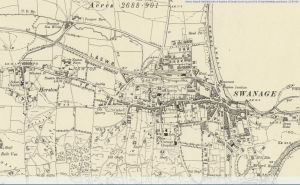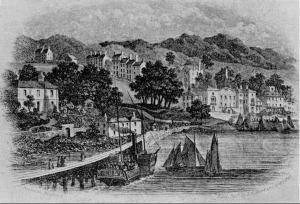Swanage Railway Arrival 20 May 1885
Arrival of the Railway
After the Royal Assent to the Act of Parliament was granted on 18th July 1881, the Railway came to Swanage in 1885. Construction started in 1883 by the contractor Curry and Reeve at a cost of £76,646 (current equivalent £9.155 m) and the Track Bed engineering started in March 1883. In May 1883, the promoters of the line George Burt, John Robinson and William Landsdowne Beal, purchased and took the first delivery, from a Steamer, the Lord John Russel, of the railway tracks.
In February 1884, the first tracks were laid from Swanage. To assist in this mammoth task, the contractor supplied a steam locomotive from Waraham.This was hauled to Swanage using 20 Shire Horses, that struggled when ascending Kingstone Hill on the Wareham to Swanage old Turnpike road.
The project was completed on 5th May 1885, inspected by the Board of trade and opened to passengers on the 20th May 1885.
In 1847 when the railway came to Wareham, there was a less expensive proposal made in Swanage by the Stone Merchant Henry Gillingham for a Tram Way from Swanage to the local quarries.
11 years later on 9 September 1858 this proposal was made again to a public meeting held in a local hotel, where the local dignitaries included representatives from Swanage, Wareham and Poole with the local MP J. H. Calcraft presiding. Thomas Phippard, a solicitor from Wareham, proposed that a branch line from Wareham would be an asset to Swanage and an application for an Act of Parliament should be made. However a show of hands showed an unanimous vote in support for the pier and tramway only project .
The tramway should be four miles long, with a 1:50 gradient running up to the west of Langton Matravers, via the Priests Way. This would enable the Stone to be transported from the quarries to the Bankers without disturbing the Swanage residents.
In November at the Black Bear Wareham another meeting was held, at this meeting Capt. Moorsom of Southampton and Dorchester Railway (SDR) produced plans and stated that Mr J. Walton of London would provide partial funding towards the total price of £12,000, if £4,000 was subscribed locally. John Mowlem then proposed the plans be approved and Messrs Phippard & Son form a company, in order to obtain an Act of Parliament. Henry Gillingham seconded and the proposition was carried unanimously. The Swanage Tramway and Pier Act received the Royal assent on 8 August 1859 4 .
Captain Moorsom
In the bold days of the early railway infrastructure, initially encouraged by Prince Albert, a keen supporter of engineering and mastermind of the Great Exhibition of 1851 that celebrated the great advances of the British industrial age and the expansion of the empire. The Southampton and Dorchester Railway (SDR) decided that there were opportunities in Swanage to exploit, one was to expand the tourist trade to Swanage and another was to mechanise the Stone trade. They were aware that a huge store of finished stone was held in storage on Swanage seafront, known locally as the Stone Bankers, where 20,000 tons were exported yearly and there was abundant unquarried stone in the surrounding hills. SDR were also aware that the stone paving was sold in London in 1840 for £2.60 per 10 square foot of paving and the Joint Stock managers or merchants of the Stone Bankers paid the quarry owners £1.18 for this amount of stone, but SDR did not know that carriage was paid by the quarry lease holder.
The lease holder were not paid in coins of the realm but in kind. All goods they purchased, to support their families, were purchased from shops owned by the Stone Merchant. This practice was stopped by an amendment to the 1831 Truck Act that listed many trades in which payment of wages must be made in coins. In 1887 this was extended to include manual labour.
The SDR chief engineer, Captain Moorsom, estimated the cost for the tramway and pier would be £12,000, where £6000 was required for the 70 metre causeway and the 168 metre long wooden pier with a completion time of 1861. To raise funds for the project he encouraged the members present to support the Swanage Pier and Tramway Company (SPT). Henry Gillingham, a stone merchant present at the meeting, stated the advantages in this proposal are: the stone quarry men in the Parishes of Swanage and Langton Matravers could store the stone at appropriate tram stations; the Stone Bankers would no longer be required, releasing the land for housing development; the High Street could be permanently repaired, removing the 20cm ruts, caused by the Stone wagons and it would make Swanage more appealing to visitors. The dust, mud and traffic created by the industry would be only apparent at the stone quarry location. This would give Swanage a transport link to the sea and when the Railway came to Swanage (1885), there would be an alternate transport link to the mainland. The equivalent cost in 2016 for the tramway would have been £741,214.
Although, this bold initiative to run a steam tramway through the residential area was not acceptable to the local landed residents, and they initiated an Act of Parliament named the Swanage Pier and Tramway Act (1858). This stated that no Steam Locomotives were allowed in the vicinity of residential property. SPT’s plans were undermined, the tramway was limited to the sea front and the only section built was from the Stone Bankers to the 1859 pier.
When complete the Stone merchants objected to paying the SPT pier tolls. They reverted to the old system where stone was placed on a two wheel cart, wheeled into the sea, offloaded into a rowing boat, taken to deeper water and transferred into a Ketch for final shipment. Although, occasionally they acquiesced and hauled the stone to the pier in a railway truck pulled by a horse. SPT did benefit from the lucrative seasonal tourists from the Bournemouth paddle steamer – but the passengers had to be agile due to the railway lines. To service the steamer and passengers SDR constructed a Coal Store and a Fish Store, east of the Stone Bankers. 5

